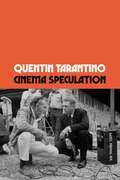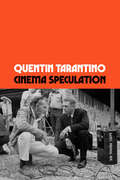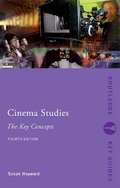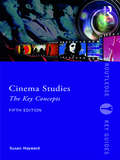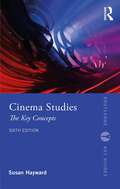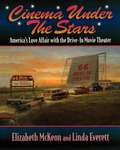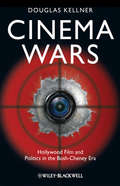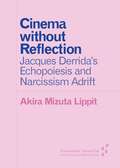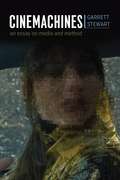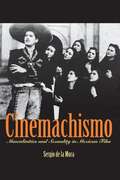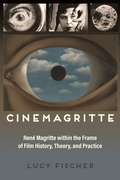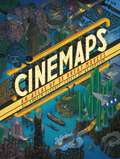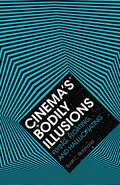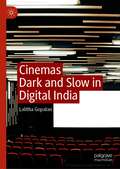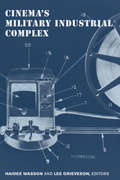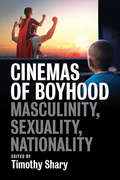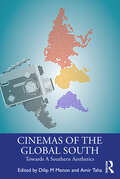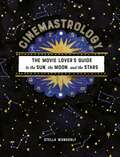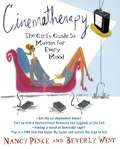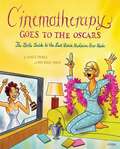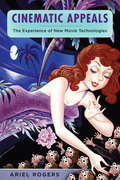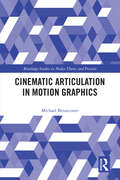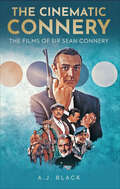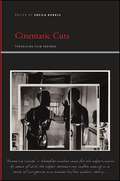- Table View
- List View
Cinema Speculation
by Quentin TarantinoA unique cocktail of personal memoir, cultural criticism and Hollywood history by the one and only Quentin Tarantino.The long-awaited first work of nonfiction from the author of the number one New York Times bestselling Once Upon a Time in Hollywood: a deliriously entertaining, wickedly intelligent cinema book as unique and creative as anything by Quentin Tarantino.In addition to being among the most celebrated of contemporary filmmakers, Quentin Tarantino is possibly the most joyously infectious movie lover alive. For years he has touted in interviews his eventual turn to writing books about films. Now, with CINEMA SPECULATION, the time has come, and the results are everything his passionate fans - and all movie lovers - could have hoped for. Organized around key American films from the 1970s, all of which he first saw as a young moviegoer at the time, this book is as intellectually rigorous and insightful as it is rollicking and entertaining. At once film criticism, film theory, a feat of reporting, and wonderful personal history, it is all written in the singular voice recognizable immediately as QT's and with the rare perspective about cinema possible only from one of the greatest practitioners of the artform ever.
Cinema Speculation
by Quentin TarantinoInstant New York Times bestsellerThe long-awaited first work of nonfiction from the author of the #1 New York Times bestselling Once Upon a Time in Hollywood: a deliriously entertaining, wickedly intelligent cinema book as unique and creative as anything by Quentin Tarantino.In addition to being among the most celebrated of contemporary filmmakers, Quentin Tarantino is possibly the most joyously infectious movie lover alive. For years he has touted in interviews his eventual turn to writing books about films. Now, with Cinema Speculation, the time has come, and the results are everything his passionate fans—and all movie lovers—could have hoped for. Organized around key American films from the 1970s, all of which he first saw as a young moviegoer at the time, this book is as intellectually rigorous and insightful as it is rollicking and entertaining. At once film criticism, film theory, a feat of reporting, and wonderful personal history, it is all written in the singular voice recognizable immediately as QT’s and with the rare perspective about cinema possible only from one of the greatest practitioners of the artform ever.
Cinema Studies: The Key Concepts 4th Edition
by Susan HaywardCinema Studies: The Key Concepts is an essential guide for anyone interested in film. Providing accessible coverage of a comprehensive range of genres, movements, theories and production terms, this is a must-have guide to a fascinating area of study and arguably the greatest art form of modern times. Now fully revised and updated for its fourth edition, the book includes new topical entries such as: CGI Convergence Cult cinema Digital cinema/Post-digital cinema Dogme 95* Movement-image/Time-image Quota quickies 3-D technology
Cinema Studies: The Key Concepts (Routledge Key Guides)
by Susan HaywardCinema Studies: The Key Concepts is essential reading for anyone interested in film. Providing accessible coverage of a comprehensive range of genres, movements, theories and production terms, this is a must-have guide to a fascinating area of study and arguably the greatest art form of modern times. Now fully revised and updated for its fifth edition, the book includes entries on topics such as: Acting Audience CGI Convergence Cult cinema Digitisation and globalization Distribution Experimental film Transnational cinema World cinemas
Cinema Studies: The Key Concepts (Routledge Key Guides)
by Susan HaywardNow in its sixth edition, this essential guide for students provides accessible definitions of a comprehensive range of genres, movements, world cinemas, theories and production terms. This fully revised and updated book includes new topical entries that explore areas such as film and the environmental crisis; streaming and new audience consumption; diversity and intersectionality; questions related to race and representation; the Black Lives Matter movement; and New Wave Cinemas of Eastern European countries. Further new entries include accented/exilic cinema, border-cinema, the oppositional gaze, sonic sound and Black westerns. Existing entries have been updated, including discussion of #MeToo, and more contemporary film examples have been added throughout. This is a must-have guide for any student starting out on this fascinating area of study and arguably the greatest art form of modern times.
Cinema Under the Stars: America's Love Affair with Drive-in Movie Theaters
by Elizabeth Mckeon Linda EverettWhen Richard M. Hollingshead Jr. first projected a movie onto a white bed sheet stretched between two trees at his home in Camden, New Jersey, in 1933, little did he know that he was on the verge of creating an entirely new entertainment industry. With America just beginning its romance with the automobile, it's no surprise that the general public found this new form of movie going irresistible. Fun and affordable, the drive-in quickly gained popularity among families with young children. And, of course, the local drive-in was a favorite weekend hangout for teenagers: a place where they could go just to meet friends or take a sweetheart for a romantic evening of movies under the stars. Although drive-ins are no longer as popular as they once were, in many communities a devoted following still seeks out the open-air theaters at twilight. Cinema Under the Stars" is a reminder of those wonderful times, as well as a recounting of the history of the drive-in experience. Here is the story, and here are the memories: B movies, concession stands loaded with goodies, screen towers, ticket booths, scratchy speakers, speaker poles, and intermission. It is all here - a nostalgic look at one of America's all-time favorite pastimes. "
Cinema Wars: Hollywood Film and Politics in the Bush-Cheney Era
by Douglas M. KellnerCinema Wars explores the intersection of film, politics, and US culture and society through a bold critical analysis of the films, TV shows, and documentaries produced in the early 2000s Offers a thought-provoking depiction of Hollywood film as a contested terrain between conservative and liberal forces Films and documentaries discussed include: Black Hawk Down, The Dark Knight, Star Wars, Syriana, WALL-E, Fahrenheit 9/11 and other Michael Moore documentaries, amongst others Explores how some films in this era supported the Bush-Cheney regime, while others criticized the administration, openly or otherwise Investigates Hollywood’s treatment of a range of hot topics, from terrorism and environmental crisis to the Iraq war and the culture wars of the 2000s Shows how Hollywood film in the 2000s brought to life a vibrant array of social protest and helped create cultural conditions to elect Barack Obama
Cinema without Reflection: Jacques Derrida's Echopoiesis and Narcissim Adrift
by Akira Mizuta LippitCinema without Reflection traces an implicit film theory in Jacques Derrida's oeuvre, especially in his frequent invocation of the myth of Echo and Narcissus. Derrida's reflections on the economies of image and sound that reverberate in this story, along with the spectral dialectics of love, mirrors, and poiesis, serve as the basis for a theory of cinema that Derrida perhaps secretly imagined. Following Derrida's interventions on Echo and Narcissus across his thought on the visual arts, Akira Mizuta Lippit seeks to return to a theory of cinema adrift in Derrida's philosophy. Forerunners is a thought-in-process series of breakthrough digital works. Written between fresh ideas and finished books, Forerunners draws on scholarly work initiated in notable blogs, social media, conference plenaries, journal articles, and the synergy of academic exchange. This is gray literature publishing: where intense thinking, change, and speculation take place in scholarship.
Cinemachines: An Essay on Media and Method
by Garrett StewartThe hero stands on stage in high-definition 3-D while doubled on a crude pixel screen in Billy Lynn’s Long Halftime Walk. Alien ships leave Earth by dissolving at the conclusion of Arrival. An illusory death spiral in Vertigo transitions abruptly to a studio set, jolting the spectator. These are a few of the startling visual moments that Garrett Stewart examines in Cinemachines, a compelling, powerful, and witty book about the cultural and mechanical apparatuses that underlie modern cinema. Engaging in fresh ways with revelatory special effects in the history of cinematic storytelling—from Buster Keaton’s breaching of the film screen in Sherlock Jr. to the pixel disintegration of a remotely projected hologram in Blade Runner 2049—Stewart’s book puts unprecedented emphasis on technique in moving image narrative. Complicating and revising the discourse on historical screen processes, Cinemachines will be crucial reading for anyone interested in the evolution of the movies from a celluloid to a digital medium.
Cinemachismo: Masculinities and Sexuality in Mexican Film
by De La Mora SergioHe focuses on three traditional genres (the revolutionary melodrama, the cabaretera [dancehall] prostitution melodrama, and the musical comedy "buddy movie") and one subgenre (the fichera brothel-cabaret comedy) of classic and contemporary cinema. By concentrating on the changing conventions of these genres, de la Mora reveals how Mexican films have both supported and subverted traditional heterosexual norms of Mexican national identity. In particular, his analyses of Mexican cinematic icons Pedro Infante and Gael García Bernal and of Arturo Ripstein's cult film El lugar sin límites illuminate cinema's role in fostering distinct figurations of masculinity, queer spectatorship, and gay male representations. De la Mora completes this exciting interdisciplinary study with an in-depth look at how the Mexican state brought about structural changes in the film industry between 1989 and 1994 through the work of the Mexican Film Institute (IMCINE), paving the way for a renaissance in the national cinema.
Cinemagritte: René Magritte within the Frame of Film History, Theory, and Practice (Contemporary Approaches to Film and Media Series)
by Lucy FischerCinemagritte: René Magritte within the Frame of Film History, Theory, and Practice investigates the dynamic relationship between the Surrealist modernist artist René Magritte (1898–1967) and the cinema—a topic largely ignored in the annals of film and art criticism. Magritte once said that he used cinema as "a trampoline for the imagination," but here author Lucy Fischer reverses that process by using Magritte’s work as a stimulus for an imaginative examination of film. While Fischer considers direct influences of film on Magritte and Magritte on film, she concentrates primarily on "resonances" of Magritte’s work in international cinema—both fiction and documentary, mainstream and experimental. These resonances exist for several reasons. First, Magritte was a lover of cinema and created works as homages to the medium, such as Blue Cinema (1925), which immortalized his childhood movie theater. Second, Magritte’s style, though dependent on bizarre juxtapositions, was characterized by surface realism—which ties it to the nature of the photographic and cinematic image. Third, Magritte shares with film a focus on certain significant concepts: the frame, voyeurism, illusionism, the relation between word and image, the face, montage, variable scale, and flexible point of view. Additionally, the volume explores art documentaries concerning Magritte as well as the artist’s whimsical amateur "home movies," made with his wife, Georgette, friends, and Belgian Surrealist associates. The monograph is richly illustrated with images of Magritte’s oeuvre as well as film stills from such diverse works as The Eternal Sunshine of the Spotless Mind, Eyes Without a Face, American Splendor, The Blood of a Poet, Zorns Lemma, The Island of Dr. Moreau, The Draughtsman’s Contract, and many more. Cinemagritte brings a novel and creative approach to the work of Magritte and both film and art criticism. Students, scholars, and fans of art history and film will enjoy this thoughtful marriage of the two.
Cinemaps: An Atlas of 35 Great Movies
by Andrew Degraff A. D. JamesonThis beautifully illustrated atlas of beloved movies is an essential reference for cinephiles, fans of great films, and anyone who loves the art of mapmaking. Acclaimed artist Andrew DeGraff has created beautiful hand-painted maps of all your favorite films, from King Kong and North by Northwest to The Princess Bride, Fargo, Pulp Fiction, even The Breakfast Club—with the routes of major characters charted in meticulous cartographic detail. Follow Marty McFly through the Hill Valley of 1985, 1955, and 1985 once again as he races Back to the Future. Trail Jack Torrance as he navigates the corridors of the Overlook Hotel in The Shining. And join Indiana Jones on a globe-spanning journey from Nepal to Cairo to London on his quest for the famed Lost Ark. Each map is presented in an 11-by-14-inch format, with key details enlarged for closer inspection, and is accompanied by illuminating essays from film critic A. D. Jameson, who speaks to the unique geographies of each film.
Cinema's Bodily Illusions: Flying, Floating, and Hallucinating
by Scott C. RichmondDo contemporary big-budget blockbuster films like Gravity move something in us that is fundamentally the same as what avant-garde and experimental films have done for more than a century? In a powerful challenge to mainstream film theory, Cinema's Bodily Illusions demonstrates that this is the case. Scott C. Richmond bridges genres and periods by focusing, most palpably, on cinema's power to evoke illusions: feeling like you're flying through space, experiencing 3D without glasses, or even hallucinating. He argues that cinema is, first and foremost, a technology to modulate perception. He presents a theory of cinema as a proprioceptive technology: cinema becomes art by modulating viewers' embodied sense of space. It works primarily not at the level of the intellect but at the level of the body. Richmond develops his theory through examples of direct perceptual illusion in cinema: hallucinatory flicker phenomena in Tony Conrad's The Flicker, eerie depth effects in Marcel Duchamp's Anémic Cinéma, the illusion of bodily movement through onscreen space in Stanley Kubrick's 2001, Godfrey Reggio's Koyaanisqatsi, and Alfonso Cuarón's Gravity. In doing so he combines insights from Maurice Merleau-Ponty's phenomenology of perception and James J. Gibson's ecological approach to perception. The result is his distinctive ecological phenomenology, which allows us to refocus on the cinema's perceptual, rather than representational, power.Arguing against modernist habits of mind in film theory and aesthetics, and the attendant proclamations of cinema's death or irrelevance, Richmond demonstrates that cinema's proprioceptive aesthetics make it an urgent site of contemporary inquiry.
Cinemas Dark and Slow in Digital India
by Lalitha GopalanThis book provides a sustained engagement with contemporary Indian feature films from outside the mainstream, including Aaranaya Kaandam, I.D., Kaul, Chauthi Koot, Cosmic Sex, and Gaali Beeja, to undercut the dominance of Bollywood focused film studies. Gopalan assembles films from Bangalore, Chennai, Delhi, Kolkata, and Trivandrum, in addition to independent productions in Bombay cinema, as a way of privileging understudied works that deserve critical attention. The book uses close readings of films and a deep investigation of film style to draw attention to the advent of digital technologies while remaining fully cognizant of ‘the digital’ as a cryptic formulation for considering the sea change in the global circulation of film and finance. This dual focus on both the techno-material conditions of Indian cinema and the film narrative offers a fulsome picture of changing narratives and shifting genres and styles.
Cinema's Military Industrial Complex
by Haidee Wasson Lee GrievesonThe vast and influential American military has been aided and abetted by cinema since the earliest days of the medium. The army, navy, and air force put films to work in myriad ways, enlisting them to entertain, train, and heal soldiers as well as to propagandize, strategize, spy, map, and develop weapons, from rifles to atomic bombs. Presenting new essays based on archival research, Cinema’s Military Industrial Complex addresses the relationship of military cinema to Hollywood, technological innovation, new modes of filmmaking, unique film styles and genres, and the rise of American soft power across the long twentieth century. This rich and timely volume is essential for scholars interested in the military’s use of media and the exercise of influence within and beyond American borders.
Cinemas of Boyhood: Masculinity, Sexuality, Nationality
by Timothy SharyDrawing from political sociology, pop psychology, and film studies, Cinemas of Boyhood explores the important yet often overlooked subject of boys and boyhood in film. This collected volume features an eclectic range of films from British and Indian cinemas to silent Hollywood and the new Hollywood of the 1980s, culminating in a comprehensive overview of the diverse concerns surrounding representations of boyhood in film.
Cinemas of the Global South: Towards a Southern Aesthetics
by Dilip M Menon Amir TahaThis book engages with the idea of the Global South through cinema as a concept of resistance; as a space of decolonialisation; and as an arena of virtuality, creativity and change. It opens up a dialogue amongst scholars and filmmakers from the Global South: India, Nigeria, Colombia, Brazil, South Africa, and Egypt.The essays in the volume approach cinema as an intertwined process of both production and perception not divorced from the economic, social, political and cultural. They emphasise film as a visual medium where form, structure and content are not separable. Through a wide array of film-readings, the authors explore the concept of a southern cinematic esthetics, in particular, and the concept of the Global South in general.The volume will be of interest to scholars, students and researchers of film and media studies, critical theory, cultural studies and Global South studies.
Cinemastrology: The Movie Lover's Guide to the Sun, the Moon, and the Stars
by Stella WonderlyPicking your perfect flick can be an overwhelming experience. But fear not! Cinemastrology answers a question that has stumped even the most avid film buff for over a century: "What movie should I watch?"From contemporary comedies to Hollywood classics, from date movies to adrenaline fests, Cinemastrology is your guide to the art of selecting viewing based on your astrological sign. It includes profiles of all the sun signs and offers an extensive list of movie recommendations for each, complete with descriptions, behind-the-scenes stories, and insights into the unique qualities of each sign, from Aries to Pisces. Sections covering the stars that light up the screen and sign-compatible suggestions based on the sign of your partner or film-viewing friend round out Cinemastrology.Getting started is easy! All you need is a birthday and a passion for movies.
Cinematherapy: The Girl's Guide to Movies For Every Mood
by Beverly West Nancy PeskeWhat can take the edge off a bad day at the office better than a movie where the boss gets his (9-5)? And, of course, that close-up of Antonio Banderas, wet and naked in a cage, is the best cure for the break-up blahs known to modern science (Never Talk to Strangers). Now, for the first time, Cinematherapy acknowledges what women have known for years, and provides a sage guide to the best movie medicine currently available for whatever ails you, whether it's a sudden hormonal shift, a bad-hair day, or a full-fledged identity crisis.
Cinematherapy Goes to the Oscars
by Nancy Peske Beverly WestGet ready for some of the best movie medicine ever made. The smash hit women's film guide Cinematherapy taught women that comfort, self-acceptance, inspiration, and humor were no farther away than the video store - and inspired the daily prime-time show on the WE Network (Women's Entertainment). Now the authors are back with a Cinematherapy take on the Oscar canon and how these award-winning films serve not only as a celluloid pharmacy but also as a window into ourselves, our relationships, and our times. Starting with the present and working backward by decade, Cinematherapy Goes to the Oscars uncovers the grand themes of each decade's award-winning films, from the Father Issue films of the seventies, with their ambiguous father figures (Patton, Kramer vs. Kramer) to bad girls acting out for disapproving fathers' love (Klute, Cabaret), to the Unsung Hero films of the fifties (On the Waterfront, The African Queen). Along the way there is great dish on who wore what on the Red Carpet, who said what in their acceptance speeches, and party tips for throwing a four-star Oscar bash, as well as returning popular sidebars like the Handy Hunk Chart. As the first female take on these sacred cows of the Silver Screen, focusing on the moments, messages, leading ladies, and supporting men that matter to us most, Cinematherapy Goes to the Oscars is the ultimate indulgence for every woman ready to curl up and take charge of her own remote control.
Cinematic Appeals: The Experience of New Movie Technologies (Film and Culture Series)
by Ariel RogersCinematic Appeals follows the effect of technological innovation on the cinema experience, specifically the introduction of widescreen and stereoscopic 3D systems in the 1950s, the rise of digital cinema in the 1990s, and the transition to digital 3D since 2005. Widescreen cinema promised to draw the viewer into the world of the screen, enabling larger-than-life close-ups of already larger-than-life actors. This technology fostered the illusion of physically entering a film, enhancing the semblance of realism. Alternatively, the digital era was less concerned with the viewer's physical response and more with information flow, awe, and the reevaluation of spatiality and embodiment. This study ultimately shows how cinematic technology and the human experience shape and respond to each other over time.
Cinematic Appeals
by Ariel RogersCinematic Appeals follows the effect of technological innovation on the cinema experience, specifically the introduction of widescreen and stereoscopic 3D systems in the 1950s, the rise of digital cinema in the 1990s, and the transition to digital 3D since 2005. Widescreen films drew the spectator into the world of the screen, enabling larger-than-life close-ups of already larger-than-life actors. The technology fostered the illusion of physically entering a film, enhancing the semblance of realism. Alternatively, the digital era was less concerned with manipulating the viewer's physical response and more with generating information flow, awe, disorientation, and the disintegration of spatial boundaries. This study ultimately shows how cinematic technology and the human experience shape and respond to each other over time. Films discussed include Elia Kazan's East of Eden (1955), Star Wars: Phantom Menace (1999), The Matrix (1999), and Thomas Vinterberg's Dogme film Celebration (1995).
Cinematic Articulation in Motion Graphics (Routledge Studies in Media Theory and Practice)
by Michael BetancourtThis book develops a critical and theoretical approach to the semiotics of motion pictures as they are applied to a broader range of constructions than traditional commercial narrative productions. This interdisciplinary approach begins with the problems posed by motion perception to develop a model of cinematic interpretation that includes both narrative and non-narrative types of productions. Contrasting traditional theatrical projection and varieties of new media, this book integrates analyses of title sequences, music videos, and visual effects with discussions on classic and avant-garde films. It further explores the intersection between formative audio-visual cues identified by viewers and how viewers’ desires direct engagement with the motion picture to present a framework for understanding cinematic articulation. This new theoretical model incorporates much of what was neglected and gives greater prominence to formerly critical marginal productions by showing the fundamental connections that link all moving imagery and text, whether it tells a story or not. This insightful work will appeal to students and academics in film and media studies.
The Cinematic Connery: The Films of Sir Sean Connery
by A. J. BlackScotland’s greatest export. The world’s first super spy. Voted the sexiest man on the planet. Sir Sean Connery was a titanic figure on screen and off for over half a century. Behind the son of a factory worker, growing up in near-poverty on the harsh streets of pre-war Edinburgh, lay a timeless array of motion pictures that spanned multiple decades and saw Connery work across the globe with directors as diverse as Alfred Hitchcock, Steven Spielberg and Michael Bay. And amongst them his greatest role, whether he liked it or not – Bond, James Bond. Author A. J. Black delves into Connery’s life for more than mere biography, exploring not just the enormously varied pictures he made including crowd pleasing blockbusters such as The Untouchables or Indiana Jones and the Last Crusade, serious-minded fare in The Hill or The Offence, and his strange sojourns into eclectic fantasy with Zardoz or Time Bandits, but also the sweep of a career that crossed movie eras as well as decades. From skirmishes with the angry young men of the British New Wave, via becoming the cinematic icon of the 1960s as 007, through to a challenging reinvention as a unique older actor of stature in the 1980s, this exploration of the Cinematic Connery shows just how much his work reflected the changing movie-going tastes, political realities and cultural trends of the 20th century, and beyond . . .
Cinematic Cuts: Theorizing Film Endings (SUNY series, Insinuations: Philosophy, Psychoanalysis, Literature)
by Sheila KunkleEditing has been called the language of cinema, and thus a film's ending can be considered the final punctuation mark of this language, framing everything that came before and offering the key to both our interpretation and our enjoyment of a film. In Cinematic Cuts, scholars explore the philosophical, literary, and psychoanalytic significance of film endings, analyzing how film endings engage our fantasies of cheating death, finding true love, or determining the meaning of life. They examine how endings offer various forms of enjoyment for the spectator, from the momentary fulfillment of desire in the happy ending to the pleasurable torment of an indeterminate ending. The contributors also consider how film endings open onto larger questions relating to endings in our time. They suggest how a film ending's hidden counternarrative can be read as a political act, how our interpretation of a film ending parallels the end of a psychoanalytical session, how film endings reveal our anxieties and fears, and how cinema itself might end with the increasing intervention of digital technologies that reorient the spectator's sense of temporality and closure. Films by Akira Kurosawa, Lars von Trier, Joon-Hwan Jang, Claire Denis, Christopher Nolan, Jane Campion, John Huston, and Spike Jonze, among others, are discussed.
